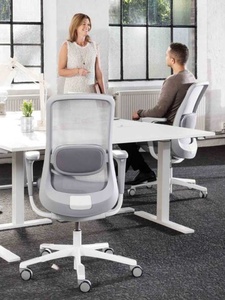Study: Forearm Supports Reduce Upper Body Pain Linked to Computer Use April 18, 2006
Providing forearm support is an effective intervention to prevent musculoskeletal disorders of the upper body and aids in reducing upper body pain associated with computer work, according to a study in The British Journal of Occupational and Environmental Medicine.
Reported in the April 18 issue, the study shows that use of large arm boards significantly reduces neck and shoulder pain as well as hand, wrist and forearm pain.
"Based on these outcomes, employers should consider providing employees who use computers with appropriate forearm support," said lead author David Rempel, MD, MPH, director of the ergonomics program at San Francisco General Hospital and professor of medicine at the University of California, San Francisco.
Study findings also show arm boards and ergonomics training provide the most protective effect, with a statistically significant reduction in both neck and shoulder pain and right hand/wrist/forearm pain in comparison to the control group, who did not receive forearm support. The boards reduced the risk of incidence of neck and shoulder disorders by nearly half.
According to the authors, musculoskeletal disorders of the neck, shoulders and arms are a common occupational health problem for individuals involved in computer-based customer service work. Specific disorders include wrist
tendonitis, elbow tendonitis and muscle strain of the neck and upper back. These health problems account for a majority of lost work time in call centres and other computer-based jobs. "Extended hours of mouse or keyboard use and sustained awkward postures, such as wrist extension, are the most consistently observed risk factors for musculoskeletal disorders," Rempel added.
The one year, randomized study evaluated the effects of two workstation interventions on the musculoskeletal health of call centre employees -- a padded forearm support and a trackball. The forearm support is commonly called an arm board and attaches to the top front edge of the work surface. The trackball replaces a computer mouse and uses a large ball for cursor motion. The researchers tested employees from two customer service centre sites of a large health maintenance organization. Employees had to perform computer based customer service work for a minimum of 20 hours per week in order to qualify for the study. For one year, 182 participants filled out a weekly questionnaire to assess pain level in their hands, wrists, arms, upper backs and shoulders.
Participants were randomized into four groups, each receiving a different intervention: ergonomics training, training plus a trackball, training plus forearm support, or training with both a trackball and forearm support. Outcome measures included weekly pain severity scores and diagnosis of a new musculoskeletal disorder in the upper extremities or the neck-shoulder region based on physical examination performed by a physician.
The trackball intervention had no effect on right upper extremity disorders. "The trackball was difficult for some participants to use," said Rempel. "Employees with hand pain may want to try them, but they should stop if it is
difficult to use."
The researchers also performed a return-on-investment calculation for the study to estimate the effects of ergonomic interventions on productivity and costs. Their calculations predicted a full return of armboard costs for employers within 10.6 months of purchase.
"Based on this study, it is in the best interest of the company and the employees to provide forearm supports and training," Rempel concluded. In the study, the authors also outline other ergonomic-specific tasks that employees who use computers can do to relieve pain on their own.
They suggest employees
- take scheduled breaks,
- maintain an erect posture, adjust chair height so thighs are parallel to the floor,
- adjust arm support and work surface height so the forearms are parallel to the floor,
- adjust the mouse and keyboard location to minimize the reach, and
- adjust monitor height so that the centre of the monitor is approximately 15 degrees below the visual horizon.
Sources: The British Journal of Occupational and Environmental Medicine; UCSF.















